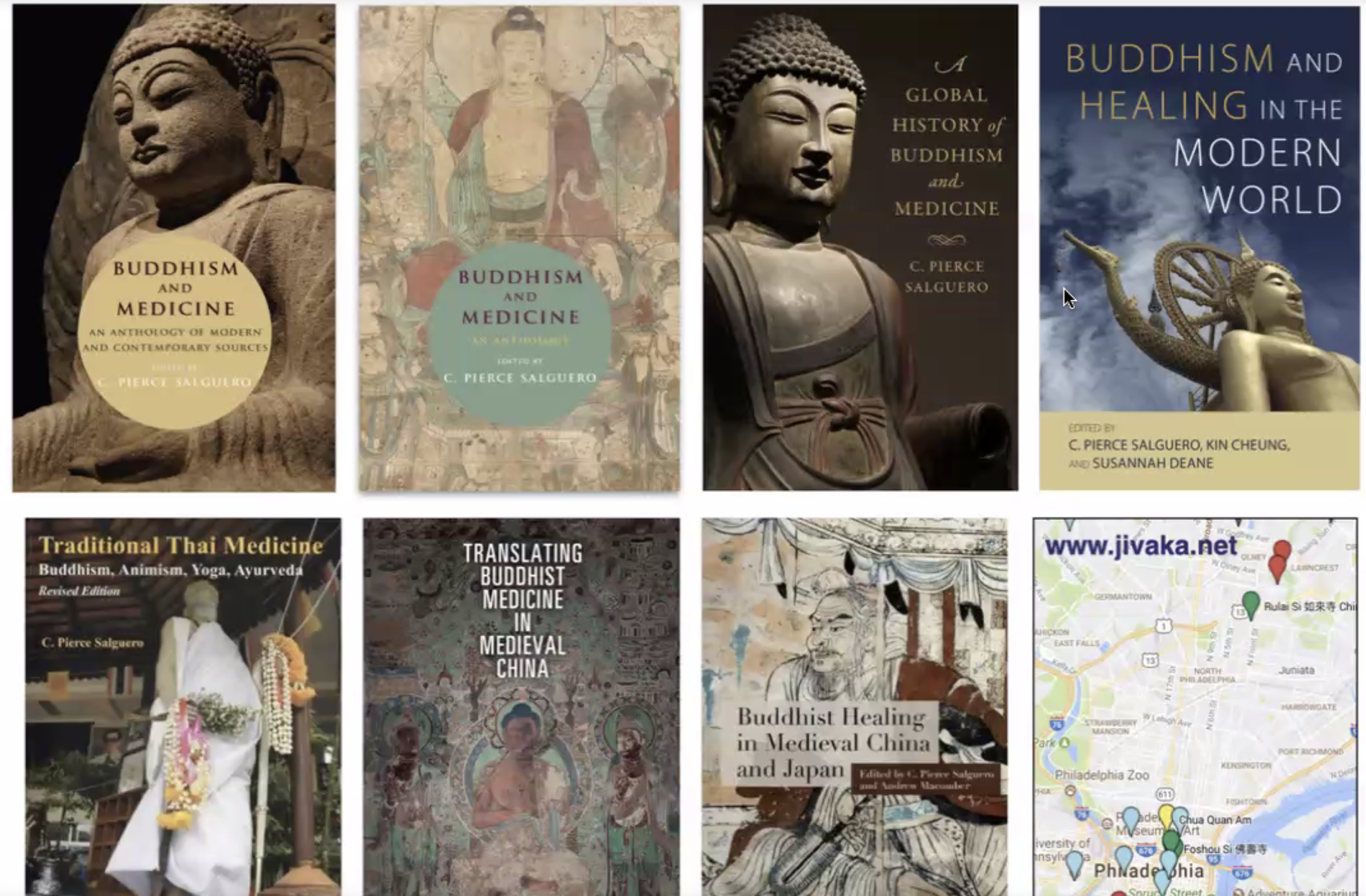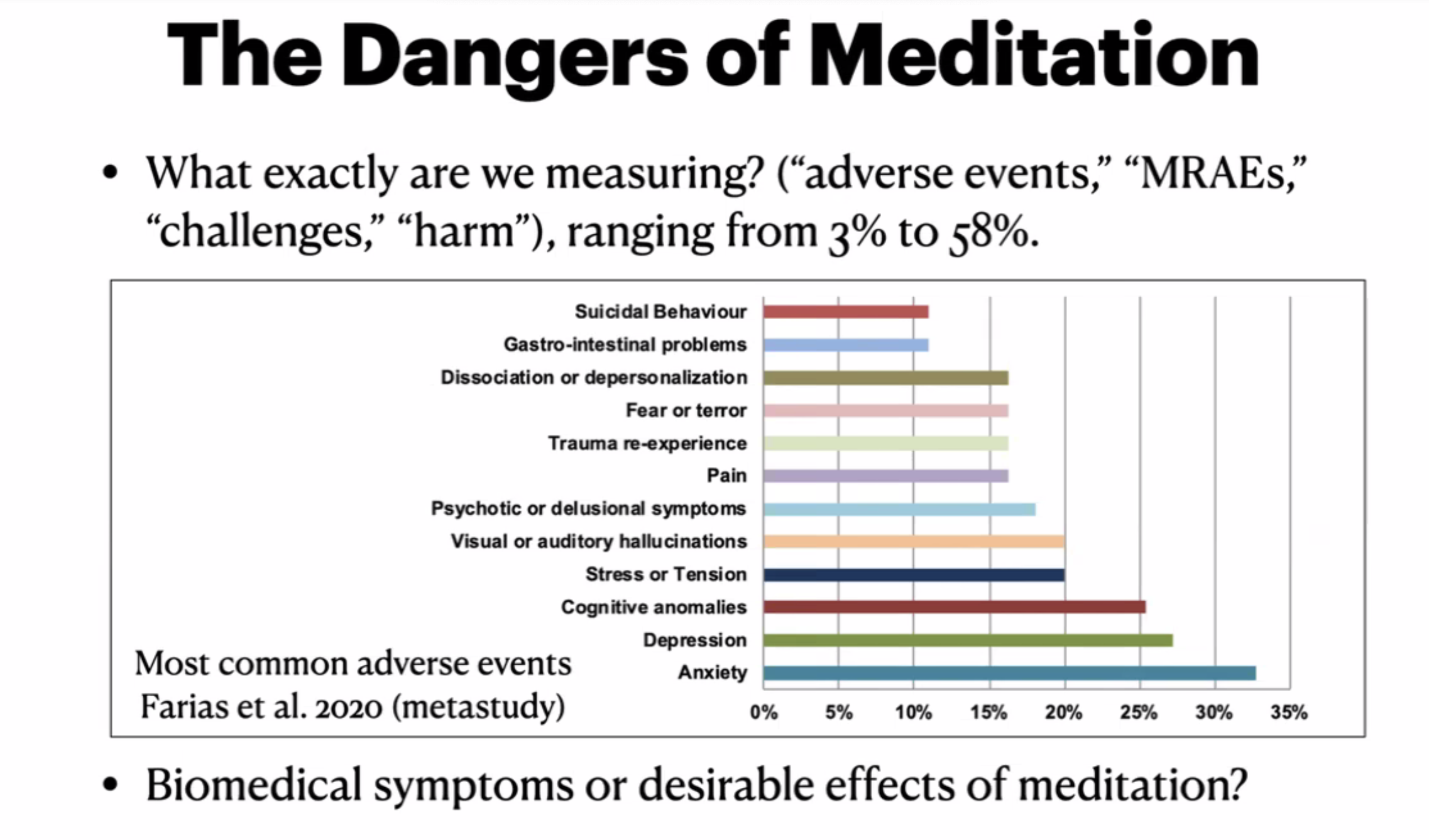Notes from a Lecture with Dr. Pierce Salguero
Author of Global History of Buddhism and Medicine

Zen byo - “zen sickness”
What are the dangers of meditation?
Meditation sickness as a grouping of different adverse effects:

Biomedical bad symptoms can also be viewed as expected/desirable effects of meditation
Dissociation or depersonalization as anatta
Visual/auditory hallucinations - visionary experiences
Buddhist responses

Related concepts in other spiritual practices & religious traditions:
spiritual emergency - comes from transpersonal psychology
qigong psychosis/deviation
kundalini syndrome
Everyone in this conversation is an english-speaking western person, debating in English-speaking Western media.
What have Asian Buddhists said about the dangers of meditation?
Scriptural and canonical Buddhist writings
Important texts:
Zhiyi
Gektsel tibetan texts - e.g. Garland of Gems
Questions
When is the appropriate time in a student’s path to introduce the potential pitfalls and the counteracting treatments?question
To what extent does the breadth of practices in Tibetan relate to prevention of meditation illness? i.e. Vajrasattva, prostrations, tonglen, etc.
Do certain traditions have greater or lesser discussion of meditation sickness?
How do descriptions of the illnesses differ across traditions?
What types/categories of practices may be most likely to give rise to meditation sickness?
Treatments
use the six breaths (liu qi)
- is this the same as the six healing sounds?
-
- Healing Sounds 六氣法 (Liu Qi Fa). Beginning and advanced levels of Healing Sounds, an integration of sound and posture to drive toxins out of the lungs, heart, liver, spleen, and kidneys. The advanced set includes exercises to detoxify acupuncture points and meridians. The Healing Sounds are widely prescribed in China and have an excellent clinical record.1
-
Visualizations that are not Buddhist
shamatha treatments:
- focus the attention on the dantien
- focusing mind on the base of a chasm six feet below your body
- fixing attention on feet
- fixing attention on the location of the symptom
- attn on internal organs to regulate them (Chinese Medical Theory)
- attn on four elements (indian medical theory)
Visualizations that work on the subtle body level
Common pattern is there’s a lot of focus on downward movement. Most of these treatment meditations focus on the lower part of the body, even the chasm below your body. Downward-moving visualization, moving energy lower in your body.
Zhiyi says throughout the day we’re focused in the senses and head, so bringing energy downward regulates the qi in the body.
Resources
- Ruth Denison
- Peter Warren
- Pierce Salguero
- Peter Levine
- Body Keeps the Score
- Meditation and psychedelic-related challenges and adverse effects
Meditation as psychoactive?
- If meditation is psychoactive, like any other psychoactive activity/intervention, it will land with each person differently.
- No psychoactive thing that has 100% benefit all the time for each person.
- I like this idea of putting meditation in the grouping with other psychoactive interventions, although it could certainly turn more people off. It also is more in line with where it started taking off in the U.S., being attractive to hippies
Dissociation
Is dissociation equal to meditation sickness, or one of many possible meditation sicknesses?
dissociation
What does dissociation feel like?
“I’m just constantly and acutely aware of my thoughts, my emotions, my sensory experiences, in a way that often feels disaggregated. The borders and boundaries around my sense of self are very permeable at times,” Lawton said. “There’s this idea that you’re going to dissolve the boundary between you and the rest of the world and you’re not going to have any anxiety or something. That has not been my experience whatsoever. Intensive meditation has to some extent changed the way that I experience the world, and some of those perceptual changes just don’t feel very good.” 1
As I lay there musing in the brisk darkness, I suddenly sensed a tightening inside me. It was as if I was being ever so gently wound. Then quickly, the pressure intensified, and I breathed in rapid-fire staccato and violently shook. I was a guitar string being tuned beyond its highest range. The string popped. A spike of fear slashed through my guts. And that’s when I split apart.
The next four hours were a hellscape of terror, panic and paranoia. There were almost no thoughts, only my body begging to escape my skin, convulsing like a fish fighting for life. The fear was a bottomless trench.
I knew nothing, except that something, everything, was terribly wrong. For minutes, I was completely immobilized. And even when I regained control, I was incapable of finding help. I wasn’t sure if I was real, or if the door to my cabin was real, or if anyone outside of it would be real.
I punched myself in the head at one point just to feel something solid. I couldn’t help myself because I couldn’t locate myself. Where was I? Who had I become? 2
The problem, I explained to them, was that I couldn’t stop being mindful or aware of everything that was going on within my mind and body, and the awareness felt like it was choking me to death. After a day of trying alternative meditation approaches, I left the retreat. 2
What are the causes of dissociation?
Why does it happen to some and not others? Or does it happen to everyone?
Should it be prevented? Or is it an inevitable part of the path of liberation?
Hakuin story 1
🔗 Footnotes
Wendy Biddlecombe Agsar, “Buddhism’s Biggest Open Secret” https://tricycle.org/magazine/meditation-sickness/ ↩ ↩2
https://danlawton.substack.com/p/when-buddhism-goes-bad ↩ ↩2